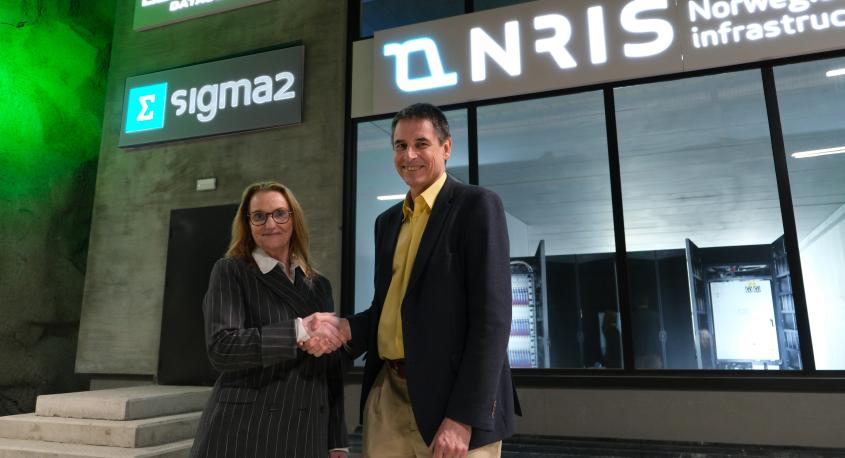The contract is now signed. Norway is getting a new supercomputer that can become a central engine in realising the potential of the government's investments in AI research.
Hewlett-Packard Norway AS (HPE) won the tender competition in May, which has a contract value of 225 million NOK. The new supercomputer will be the most powerful in Norway's history and will contribute to a significant boost for national research and innovation in AI.
—This is a big step forward for Norway as a knowledge nation. We must be less dependent on foreign actors to keep up in the AI race. We must ensure that we have enough computing power ourselves. This is crucial to ensure Norwegian knowledge preparedness and national security, says Minister of Research and Higher Education Oddmund Hoel (Sp) in a press release from the Ministry of Education and Research.
Supercomputers like this can perform large and complex calculations, often called high-performance computing (HPC), significantly faster than regular computers. This makes them indispensable tools for data-oriented research like in medicine, climate, language, and artificial intelligence (AI). The new machine will meet today's demand for computing power and have enough capacity to meet further expected needs over the next 5 years. It will be available to researchers across the country.
HPC systems are expensive, challenging to operate, and require specialised competence to use. Therefore, it is appropriate that the state owns national supercomputers that can be used by researchers, regardless of their affiliated research institution or field of study. In Norway, the state-owned company Sigma2 AS is responsible for procuring and operating the national machines. The services are operated in collaboration with the Universities of Bergen, Oslo, Tromsø, and NTNU under the name Norwegian research infrastructure services (NRIS).
Groundbreaking technology for Norwegian research
Research in an increasing number of fields is data-driven, and the need for computing power is therefore almost insatiable.
—It is crucial that we invest in computing power and AI technology now to ensure that Norwegian research does not lag in the years to come. Our acquisition of the new system from HPE represents a good step in the right direction, but much more is needed. Access to advanced technology like this, and specialised competence to use it, will be essential for digital transformation in several sectors going forward, says Gunnar Bøe, Managing Director of Sigma2.

Supercomputers have very advanced and expensive processors, called Graphics Processing Units (GPUs), which cannot be compared with those found in home PCs. The delivery from HPE is a Cray Supercomputing EX system that provides a total of 304 of the most advanced GPUs on the market today (NVIDIA GH200 96 GB). Not only do they have enormous computing capacity, they are also compatible with a wide range of software and programming languages used in data-driven research. This makes the GPUs from NVIDIA very popular among researchers in many fields, especially in AI.
—Large language models have revolutionised the AI world. Significantly expanded GPU capacity in the national Sigma2 collaboration is a prerequisite for research on and development of large Norwegian language models. This investment, with a focus on AI computing power, must be a step on a national research journey characterised by high speed and international competition directly related to computing and storage capacity, says Stephan Oepen, Professor of Informatics at the University of Oslo.
Increased focus on sustainability
The new supercomputer will be installed during the spring and summer of 2025 in Lefdal Mine Datacenter (LMD) at Nordfjordeid on the West Coast. Sigma2 secured data centre capacity in the old mine that was converted into a data centre in 2021. The data centre model was chosen to take advantage of economies of scale, have good access to areas, and have flexibility in scaling up. NIRD, the Norwegian infrastructure for research data, is already in operation there. The new machine from HPE will be the first national HPC system to be installed in the data centre.
Despite the new supercomputer being significantly more powerful than Sigma2's previous generation of high-performance computing systems, power consumption will be reduced by more than 30 %. Large high-performance computing facilities like this generate large amounts of excess heat that require cooling. In LMD, cold water will be pumped into the system directly from the nearby fjord. The heated return water can be reused by local businesses.
—HPE’s collaboration with Sigma2 at the Lefdal Mine Datacenter reflects our commitment to advancing scientific research capabilities in Norway and Europe. HPE’s solution based on our HPE CrayEX supercomputer platform integrating the latest generations of AMD processors and Nvidia accelerators, interconnected with HPE Slingshot will support Sigma2’s vision of a sustainable and efficient infrastructure that will empower researchers to address pressing global challenges and accelerate HPC & AI research in Norway, says Damien Declat, General Manager, SuperComputing HPC & AI Europe, Middle East, Africa and Latin America at HPE, in a statement from HPE.